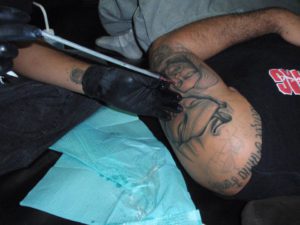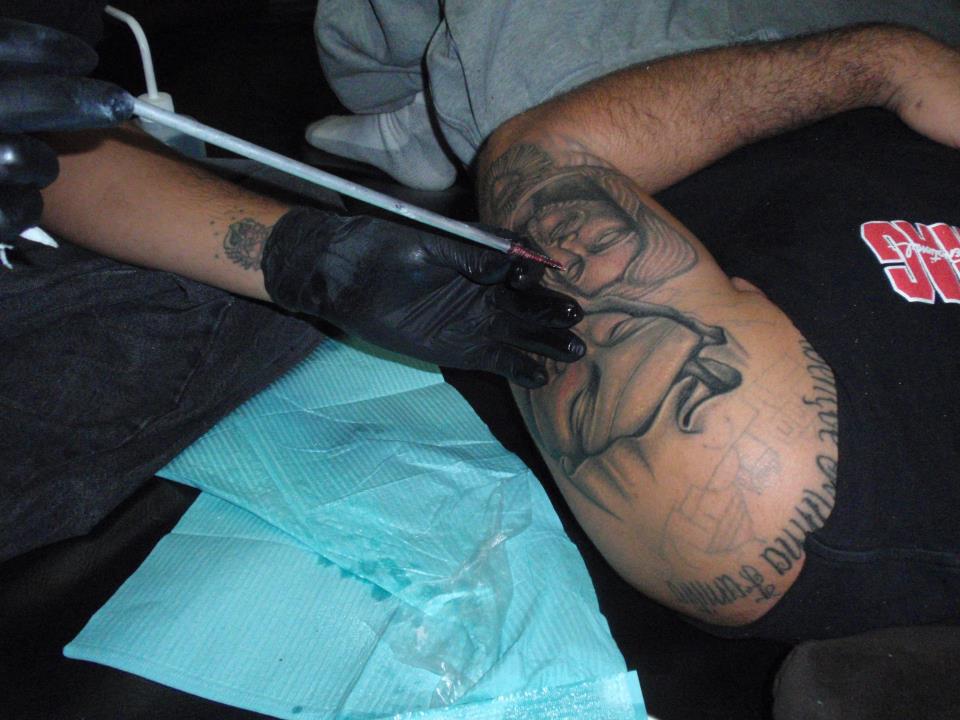Staff Writer
@sp3ctor20
The process begins with a simple stencil reproduced from a sketch and a customer on the bed, waiting. The stencil is pressed onto the skin of the customer to create lines to trace over and an image to follow. With a long piece of bamboo attached to a needle and dipped into ink, the artist holds the bamboo in such a way that the striking process will be precise. With his left hand he grasps the needle end, guiding it across the stencil and with his right hand he holds the top of the bamboo shoot for stability. Slowly, he taps the bamboo needletip across the lines of the stencil markings and leaves marks of his own on the skin.
The process is gruelling, as his hands and arms become the machine used to permanently implant ink onto the body. After the process is over the customer’s upper arm is covered with shading and crisp black lines that form a picture of Jesus and Mary. It’s all in a day’s work.

For many who get a bamboo tattoo for the first time, it feels like a vibration shooting down to your bone through layers of skin. It’s uncomfortable for many as the process takes hours, but the finished product lasts a lifetime.
Even though many have had a tattoo done before, only some have ever had an authentic Thai bamboo tattoo. This ancient art form dates back over 5,000 years, when Buddhist monks would tattoo soldiers prior to battle with marks of strength to protect them in battle. Exhumed mummies were found with still visible bamboo tattoos from Thailand and surrounding regions.
Todd Santos, owner and founder of Bamboo Tattoo Studio on the Queensway, took this ancient world technique and threw it into modern society, and Western culture is already intrigued by the process.
“Angelina Jolie flies across the world to go get this done, so I thought I’d bring Thailand to you instead,” explains Santos.
The original idea to start the now three-year-old shop came at a time when tattoos were at peak popularity. “I went on a vacation to Thailand to go get tattooed. As I was getting tattooed on the beach, I was thinking that it was amazing that there were no other tattoo shops in Canada that did it,” says Santos.
Once Santos’ arm tattoo was completed, he began his journey back to Canada to research the possibility of opening a Thai-themed shop with an authentic bamboo artist from Thailand.
He found this process to be more difficult than originally thought as the tattoo style was unknown to Canadian law.
“We always have to follow the health regulations,” says Santos. “But with bamboo I had to make my own health regulations and show it to the government for approval. I showed them how I use it, they tested it, and they were okay with the process.”
By doing so, he set the national standard for what any other bamboo tattooist would have to follow in the future.
Today, Santos has two tattoo artists working at his studio: machine artist, Maddelina Ruggiero; and bamboo artist, Nantachai Thungngoen, who each have several years of experience.
It takes a lot of experience to learn the meticulous process. Compared to ordinary (machine) tattooing, it’s a little bit slower and has its own unique technique.
According to Santos, the process is done with tools and devices that are handmade.
“The sticks are all hand-carved out of bamboo, and the needles are all put together in shop,” says Santos. “Basically we attach the needles to the stick and it’s kind of drawn on to you.”
The freedom from electric devices allows for steady hand-eye coordination to be used to its fullest. The technique also allows the artist to work on virtually any part of the body while allowing the customer to lie how they feel most comfortable.
The materials and the technique also explain why bamboo tattoo prices are slightly more expensive than the machine tattoos. At the Bamboo Tattoo studio, there is a flat rate for the materials that are used and an added price for how long the tattoo takes to finish. Most of the time it varies for every customer.
One aspect of bamboo tattooing that many newcomers ask about is whether it hurts or not. While getting tattooed comes with a certain level of pain by default, bamboo tattooing is allegedly no more painful than machine tattooing.
“Pain-wise, to each their own, but it’s definitely less abrasive on the skin,” says Santos. “There is no bleeding or scabbing, and the healing time is practically immediate. Pain-wise it still hurts, but you are getting a tattoo. They are comparable in pain; they definitely both hurt.”
Since bamboo tattoos stay above the dermis, there is no bleeding involved, causing fast healing. It explains why a bamboo artist can continue working on a piece the following day, while a machine artist must wait until the work is completely healed to continue.
Though the trend has picked up over the years, it’s still a word-of-mouth art form in Toronto. Santos is planning on opening up more locations and expanding his current shop to include an art gallery of exceptional tattoos, once more people are exposed to the unique process. He’s also planning on returning to Thailand to see if he can add another artist to his team.
But for now, it’s another day of bonding ink to skin, and striving towards pushing the art form further.




